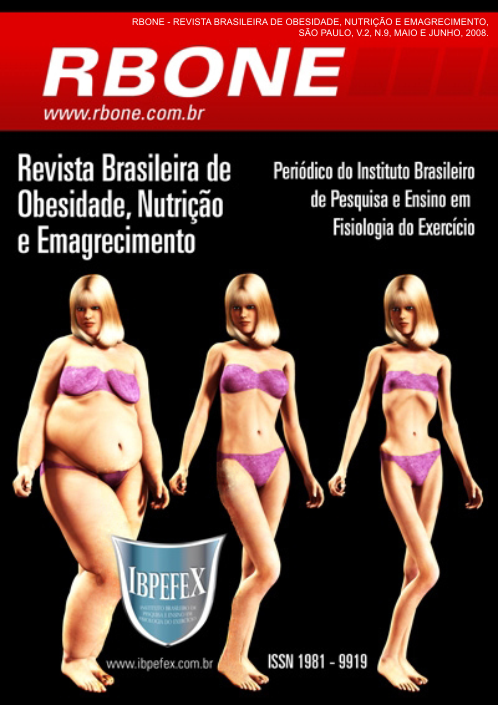Profile anthropometric and nutritional of practicing women of resistance training
Abstract
Some of the physical education professional's most important tools are the manipulation of the individuals' metabolic rate, contributing to the control of the corporal weight and increase of the life quality. The resistance training is themost effective exercise method for the development of the muscular force and it has been prescribed for the improvement of the health and of the physical fitness. The general objective of the present study was to evaluate the body composition and nutritional status of women's resistance trainers. The participants had the age between 18 and 25 years; experience with resistance training for the least 12 months. The assessment anthropometric consisted of weight, height, BMI and fat percentage. The evaluation of the caloric consumption was accomplished through a reminding of 24horas together with the alimentary registration of 3 days, this last one being answered by the participants. The percentage of fat of 17% found in the apprentices was when compared with the dear percentage for women of the same age group. The appraised group consumed an average of 1300 Kcal, while his/her medium energy need was of 2100 Kcal, counting a caloric deficit of 800 Kcal. This reveals that the participants of the study ingest less calories of the they would owe, influencing directly in the anabolic effect that the muscular activity provides, reducing the capacity of muscle reconstruction. It is ended that the percentage of practicing women's of muscular activity fat is inferior the one of sedentary women of the same age, due to the beneficial effects of the resistance training.
References
- Ross, R.; e colaboradores. Exercise-induced reduction in obesity and insulin resistance in women: a randomized controlled trial. Obes Res.12(5):789-798, 2004.
- Guedes, D.P.; Guedes, J.P. Controle do peso corporal: composição corporal, atividade física e nutrição. 2ed. Editora Shape, Rio de Janeiro, 2003.
- American College of Sports Medicine and Dietitians Canada Joint Position Statement. Nutrition and Athletic Performance. Med Sci Sports Exerc 2000;32(12):2130-2145.
- Jackson, A.S.; Pollock, M.L.; Ward, A. Generalized equations for predicting body density of women. Med Sci Sports Exerc. 1980;12:175-81.
- Loucks, A.B. Energy balance and body composition in sports and exercise. J Sports Sci, 22:1-14, 2004.
- Drinkwater, B.L.; Nilson, K.; Ott, S; C.H. Chesnut. Bone Mineral Density after Resumtion of Menses in Amenorrheic Athletes. JAMA 256: 380-382, 1986.
- Nicklas, B.J.; Hackney A.C.; Sharp, R.L. The menstrual cycle and exercise: performan-ce, muscle glycogen and substrate responses. Int. J. Sports Med. 10: 264–269, 1989.
Authors who publish in this journal agree to the following terms:
- Authors retain the copyright and grant the journal the right of first publication, with work simultaneously licensed under the Creative Commons Attribution License BY-NC which allows the sharing of the work with acknowledgment of the authorship of the work and initial publication in this journal.
- Authors are authorized to enter into additional contracts separately for non-exclusive distribution of the version of the work published in this journal (eg, publishing in institutional repository or book chapter), with acknowledgment of authorship and initial publication in this journal.
- Authors are allowed and encouraged to post and distribute their work online (eg, in institutional repositories or on their personal page) at any point before or during the editorial process, as this can bring about productive change as well as increase impact and impact. citation of published work (See The Effect of Free Access).






